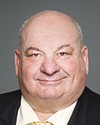moved:
Motion No. 2
That Bill C-2 be amended by deleting Clause 42.
Mr. Speaker, thank you for the ruling on this amendment indicating that it is within the proper scope of the rules and admissible.
The amendment deals with the specific section of a very large bill, an omnibus crime bill, and specifically with that part of the bill that deals with the dangerous offender designation in the Criminal Code.
Just quickly, the balance of Bill C-2 encompasses five separate pieces of legislation that were before this House in the previous parliamentary session. The dangerous offender section at that time was Bill C-27. It has now been incorporated into Bill C-2.
We had commenced work on that in a special legislative committee prior to prorogation. The prorogation by the government of course ended that bill, as it did the other four, three of which by the way were in the Senate, and the fourth one was out of committee at report stage in the House.
So now, because of what I think is a very foolish decision but a very political decision on the part of government, we are having to go back through all of those four bills and we have wasted a significant amount of time.
The government is historically very proud to stand in this House and accuse the opposition parties of delay. Of course, what has happened here has been entirely on its desk and it is something of which the Conservatives should be ashamed.
To come back to Bill C-27, as it was then and now that part of Bill C-2, the dangerous offender section of the Criminal Code has a history going back in this country to 1978 at which time it was incorporated.
I do not think there is any disagreement about this no matter which political party one belongs to, that there are individuals in our society that we are not able to cope with in terms of rehabilitating them. They commit serious, oftentimes heinous, violent crimes against other residents of Canada. When we use our traditional attempts to deal with them by way of prison terms, oftentimes psychiatric or psychological treatment programs, they are not successful.
Our psychiatrists, our psychologists and our best experts admit there is a very small number of individuals that we simply, as a society in terms of our psychological and psychiatric treatment modalities, are not able to treat and rehabilitate to the point where they are no longer a risk to society once released from our prisons. The dangerous offender section was introduced into the Criminal Code to deal specifically with those individuals.
Based on some very good research from the Library of Parliament, since 1978 we have had 384 individuals, up until the spring of 2005 so it is a bit more now, all male, designated as dangerous offenders. It is interesting to note that of those 384, 333 as of April 2005 were still in custody, still in prison. Only 18 had been released and were on parole. The balance of approximately 33 died in prison. I think this is the point that we need to recognize.
This designation, unlike a conviction for first degree murder and a life sentence, is in fact a life sentence in the 90 percentile of the cases. These individuals never get out. It is a recognition that we are not capable of dealing with them. They stay in custody, in prisons, for the balance of their lives and literally, as I have said, die in prison. That is what we are dealing with when we are dealing with a dangerous offender designation.
As I indicated earlier, there are no women who have been designated, up until April 2005. There are a couple of applications outstanding against women currently.
One of the other points that I would make that comes out of the research done by the library is that a full one-fifth, 20%, of all the individual criminals who have been designated are from the aboriginal population, from our first nations.
There is no question, and we see this more when we look at statistics in the United States, that subgroups within our society often times are individuals who are more targeted and receive greater punishment.
I am not going to suggest for a minute that the designations in those cases were inappropriate; they may or may not have been. However, that is the reality, given that our aboriginal population in this country is roughly 3% of the population but slightly over 20% are designated as dangerous offenders.
We know that this is a section of the Criminal Code that we would use, obviously, very sparingly. The issue of the constitutionality of this section has been to the Supreme Court on a number of occasions and reviewed also by a number of our appeal courts at the provincial level.
The message that comes out very clearly is that it is to be used sparingly, that it is to be used with extreme caution, that the individuals who are confronted with this are to be given the greatest amount of doubt as to the usage against them because of the consequences.
I want to repeat that the consequences in more than 90% of the cases are that these individuals, once designated as dangerous offenders, will stay in prison for the balance of their life. They will never get out.
Faced with that, if we look now at the bill that is before us, Bill C-2, the government has introduced into clause 42 a provision for a reverse onus. For those in the public who do not have a law degree and do not fully appreciate this, that is saying, under these circumstances, to the individual criminals, “If you meet this criteria, you have to prove to the judge who is hearing the case for the designation of dangerous offender why you should not be held in custody in prison until the rest of your life”. That is really what they will have to do.
That flies in the face of the charter. This section will not survive a charter challenge. Under those circumstance, and Mr. Speaker, I see you signalling that I have only a minute left. I thought these were 20-minute sessions. No. That is unfortunate because I had a lot more that I wanted to say.
My amendment, pure and simple, would delete the reverse onus from this bill because it would not survive a charter challenge. We are going to have tremendous litigation on this and at the end of the day one of our superior courts, or even the Supreme Court of Canada, will strike this section down. The amendment would take care of that right now and we could save all that trouble.







